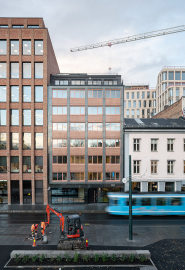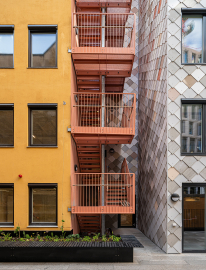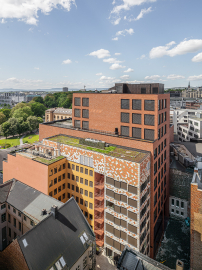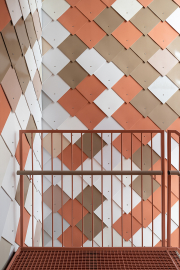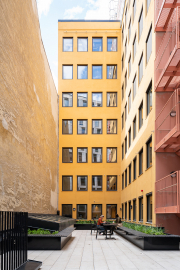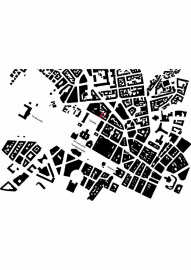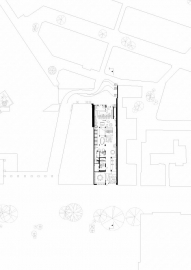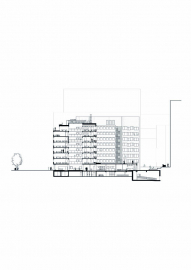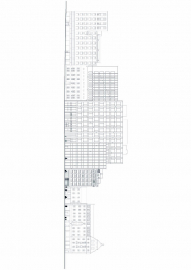Kristian August Street 13
KA13 is a groundbreaking project with reuse as the overarching goal. A modest office building from the 1950's has been preserved instead of demolished, and redeveloped with a new 8 storey extension using mostly reused building materials. The project is a first in Norway's modern history to extensively employ the reuse of building materials.
KA13 is located in central Oslo. A formerly dilapidated building has become a bright and fully revitalized, modern office- and coworking space. The project consists of two parts: rehabilitation of the existing building and a new extension, as well as upgraded technical facilities. The extension is predominantly made from a wide range of reused building materials, sourced from different construction sites around Norway. In numbers, KA13 has achieved a local reuse of ca. 80% and emission reductions of ca. 70% for the project as a whole. The programming has remained unchanged with offices on all floors above ground level. However, some new functions have been added, such as communal functions and bicycle parking in the basement, roof-top terraces and common areas throughout the building, adding value to the project.
KA13 stands as a monument to reuse, but the journey has been challenging and eventful. The reuse process is different from regular construction, and the project is heavily effected by the materials that were available during the project period. The client, known for high quality and future-oriented projects, wished to lead the way with an innovative project. We have been working with reuse and the transformation of buildings for quite some time, acquiring useful skills and knowledge. However, extensively reusing single building components, as done in KA13, is a groundbreaking process. This required strategies fine tuned through interdisciplinary processes, where all disciplines were tightly involved every step of the way. Since there is currently no system for qualifying building materials for reuse, all materials had to be sourced, examined and prepared separately. Each component was evaluated by an interdisciplinary team on a variety of criteria; from cost and service life, to function and aesthetics. After rigourous evaluation and being cleared for use, components were prepared for transportation, storage and on-site installation.
Buildings account for a large part of our resource use in terms of materials, energy and waste. The way KA13 challenges established norms is a big step towards increased suistainability. In addition, the preservation of buildings is highly valuable for contextual identities and history, which makes a profound contribution to a more sustainable society. A predominance of materials used in KA13 came from donor-buildings within a short distance. We have reused concrete slabs from old government facilities and steel structures from warehouses, with the windows coming from an incorrect order made on a different project. The railings are sourced from an old swimming hall and the facade cladding consists of panels from various projects around Oslo. Old radiators, doors, wall coverings and even furniture was saved from the original building and carefully restored. The field of reuse is largely about systems, regulations and factors outside architecture itself. Despite several challenges we have achieved results which few thought possible, thus paving the way for others to follow as we strive to lead the construction industry towards a more sustainable future.

